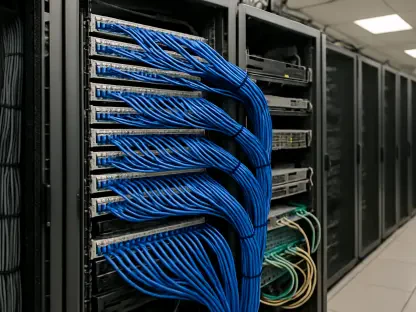As modern enterprises strive for real-time data processing and reduced latency, the implementation of edge data centers has emerged as a critical solution. Edge data centers bring computational power closer to data sources, fostering timely insights and optimized costs. This article outlines the key considerations, drivers, and strategic steps for enterprises planning to adopt and implement edge data centers.
Edge data centers act as a distributed extension of an organization’s IT infrastructure. By processing data at or near the source of data generation, these centers provide immediate insights and reduce the inefficiencies of relying on distant cloud or central data facilities. They vary in size and positioning, from compact setups in wiring closets to modular prefabricated structures at strategic locations like manufacturing plants and retail stores.
Understanding Edge Data Centers
Edge data centers blend various elements, including hardware, software, applications, data management, connectivity, security, and advanced analytics. Their primary function is to process immediate data locally while sending more extensive data sets to central data centers or cloud infrastructures. This hybrid approach helps businesses optimize their IT ecosystems by balancing on-premises and cloud-based resources.
The capability of edge data centers to handle data right where it’s generated, be it at a retail shop’s backroom or near industrial machinery, means that organizations can avoid significant renovations and effectively integrate new technology stacks. This integration is a strategic advantage, enabling companies to respond faster to operational demands. From an infrastructural perspective, edge data centers are designed to be flexible and scalable. They can be deployed quickly and efficiently in diverse environments, maximizing their utility and value across various sectors. This adaptability is crucial in today’s fast-paced business landscape, where time-to-market can significantly impact competitiveness and profitability.
Key Drivers for Edge Data Centers
One of the pivotal drivers for the adoption of edge data centers is the proliferation of Internet of Things (IoT) devices. From remote sensors to vehicle fleets and industrial robots, IoT devices generate massive volumes of data requiring swift processing. Managing this data efficiently at the edge mitigates the costs and delays of transmitting raw data to the cloud. Processing data locally also reduces network bandwidth usage and lowers costs. Real-time analytics can be conducted on-site, resulting in actionable insights without waiting for cloud-based analysis. This is particularly advantageous for time-sensitive applications like predictive maintenance in manufacturing organizations, where immediate data processing can prevent equipment failures and downtime.
Another driver is the growing demand for enhanced customer experiences across various industries. Edge data centers enable real-time analytics and personalized services, which can significantly improve customer satisfaction and engagement. For instance, retailers can offer instant discounts based on customer interactions with products, creating a more dynamic and responsive shopping experience.
Use Cases Across Industries
Edge data centers have wide-ranging applications across various industries. In manufacturing, they enable real-time monitoring and predictive maintenance, preventing equipment failures and ensuring optimal operations. Healthcare sector applications include support for remote patient monitoring and telemedicine, processing vast amounts of data from wearable devices for immediate healthcare interventions. Retailers leverage edge data centers for enhanced video surveillance and customer behavior analytics to improve security and optimize in-store experiences. Meanwhile, in energy and utilities, edge centers enhance system reliability by facilitating remote equipment monitoring and real-time data analysis, which can prevent outages and improve efficiency. For example, real-time analytics can optimize energy distribution and reduce operational costs by identifying inefficiencies promptly.
The transportation sector also benefits significantly from edge data centers. Organizations with large fleets can use edge centers to manage real-time alerts and predictive maintenance, ensuring vehicle safety and efficiency. This capability is particularly useful for logistics companies, where timely deliveries are crucial for customer satisfaction and operational success.
Requirements and Considerations
Deploying edge data centers involves addressing specific hardware and environmental needs. For example, ruggedized servers might be necessary in conditions like factories or mining sites, where extreme temperatures, dust, and vibrations are commonplace. Application-specific design is also vital, as different use cases demand different bandwidth, storage, and analytics capabilities, making it essential to tailor solutions to meet these unique requirements.
Gateways play a significant role in ensuring smooth data movement regardless of protocols, while effective data management systems help determine what data should be processed locally or sent to larger centers. Security is another critical consideration, as edge data centers present new attack surfaces and potential vulnerabilities, requiring robust security measures and data privacy protocols. Implementing encryption and secure access controls can help mitigate these risks.
Enterprises must also consider the physical infrastructure needed to support edge data centers. This includes having adequate physical space and ensuring reliable power and cooling systems. In remote or harsh environments, additional measures may be required to protect the hardware and maintain operational integrity under adverse conditions.
Trends in Edge Data Centers
The concept of data gravity is reshaping how organizations view their data infrastructures, with data and compute power moving closer to the data generation sources. This trend is driven by the increasing data volumes from IoT devices, with IDC predicting 41.6 billion such devices by 2025, generating 80 zettabytes of data. This massive data generation underscores the need for efficient and localized data processing capabilities provided by edge data centers.
Spending on edge solutions is also set to grow significantly, reflecting the rising importance of edge computing in modern IT landscapes. The market is diverse, with contributions from cloud providers, traditional IT vendors, telecom companies, and CDNs, each bringing unique solutions to the table. Industry analysts predict that enterprise and service provider spending on edge solutions will reach $317 billion by 2026, demonstrating the expanding role of edge data centers in technology and business strategies.
Another trend is the integration of advanced technologies such as artificial intelligence (AI) and machine learning (ML) in edge data centers. These technologies enhance the capability of edge centers to perform complex data analysis and make real-time decisions. The convergence of AI, ML, and edge computing opens new possibilities for innovation and efficiency, driving the continuous evolution of edge data centers.
Leading Edge Data Center Vendors
Several vendors lead the edge data center market with distinct offerings. Akamai, through its Gecko platform, utilizes a vast array of global points of presence to reduce latency and enable new use cases. AWS extends its infrastructure to edge locations via AWS Outposts, offering local cloud service use and ensuring consistent performance and reliability across different environments.
Companies like Dell, Google, HPE, IBM, and Microsoft provide a mix of hardware, software, and management solutions tailored for edge environments. Oracle and Verizon further contribute with ruggedized designs and 5G connectivity solutions, respectively, enhancing the practicality and performance of edge data centers. These vendors are continually evolving their offerings to meet the dynamic demands of the market, ensuring that enterprises have access to cutting-edge solutions.
In addition to their product portfolios, leading vendors also emphasize comprehensive support services, including consulting, deployment assistance, and ongoing management. This end-to-end support ensures that enterprises can smoothly transition to edge computing and maximize the benefits of their investments.
Key Considerations for Enterprises
Before diving into edge data centers, businesses must pinpoint their specific operational benefits and underlying business drivers. Evaluating key factors like physical space, available staff, and the necessary skills for remote setups is essential. This also involves deciding whether to build their own facilities or collaborate with existing providers. Such assessments help determine the most cost-effective and efficient approach to deploying edge data centers while utilizing existing resources effectively.
Financial considerations are also vital. Options range from traditional capital expenditures to flexible pay-as-you-go models. Ensuring these investments align with the broader IT strategies and support long-term digital transformation goals is crucial. Integrating edge data centers into the existing infrastructure should be seamless, and enterprises need to think about how edge computing fits into their broader IT roadmap and future innovation plans.
Security and governance are critical. Robust strategies must be in place to manage IoT data securely and adhere to regulatory requirements. This means implementing strong security protocols like encryption, access controls, and continuous monitoring to safeguard sensitive data. Governance frameworks should also be established to ensure compliance with industry standards and legal mandates.
Edge data centers mark a significant shift in data processing driven by the explosion of IoT devices and the vast amounts of data they generate. By bringing computational power closer to data sources, edge data centers enable real-time analytics, reduce latency, cut costs, and open new business opportunities. Their diverse applications across sectors—from manufacturing to healthcare and retail—underscore edge computing’s flexibility and essential role. Strategic alignment with IT goals, careful attention to operational demands, and smart vendor choices are crucial for successful edge deployments.









